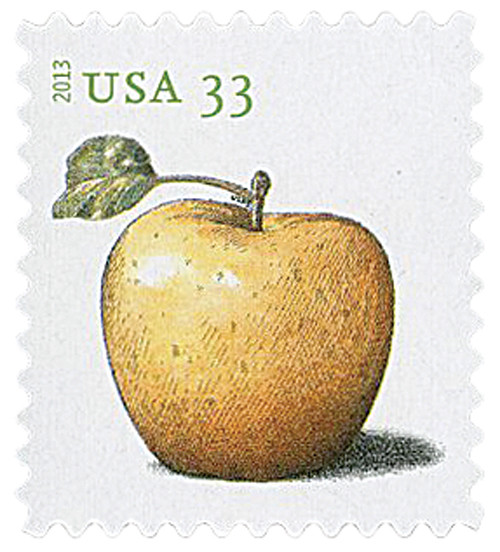
# 4729 - 2013 33c Apples, Granny Smith
U.S. # 4729
2013 33¢ Granny Smith
Apples
Several families from Peasmarsh, East Sussex, left England bound for New South Wales in 1838. British government agents had recruited them to bring their agricultural skills to the colony. Among the group was Maria Ann Smith, the descendant of a long line of fruit tree growers. Maria and her husband settled in present-day Eastwood, Australia, where they labored for other farmers. They eventually bought land in the region, which features a warm climate, ideal for fruit growing.
One day Maria discovered a seedling in her compost, which may have taken root in a shipping crate she brought home from the local market. Soon, her “Granny Smith” seedling was developed by others and began winning prizes in the cooking apple class. Long after Maria’s 1870 death, Granny Smith apples became a commercial success that accounted for a major share of Australia’s annual exports.
Granny Smith apples are crisp and hard with an acidic taste. Firm and resistant to bruising, the variety exports well and became the first truly “international” apple. These traits – and the “apple core” play on words – may explain why the Beatles chose the fruit as their Apple Corps record logo. Ironically, Sir Paul McCartney’s favorite residence is his farmhouse in Maria Smith’s English village, Peasmarsh.
Artist John Burgoyne created the apple artwork for this stamp using watercolor with pen and ink before adding finishing touches with computer software.
Value: 33¢ domestic postcard rate
Issued: January 17, 2013
First Day City: Yakima, WA
Type of Stamp: Definitive
Printed by: Banknote Corporation of America for Sennett Security Products
Method: Offset printing in sheets of 200, with 10 panes of 20
Perforation: Serpentine Die Cut 11 ½ x 10 3/4
Self-Adhesive
Quantity Printed: 37,500,000 stamps
Apples have been pictured on U.S. stamps since 1966, when one was issued to honor Johnny Appleseed (U.S. #1317). Apples were also pictured on a pair of 2001 definitives (U.S. #3491 and #3193), the 2002 Greetings from Washington stamps (U.S. #3607 and #3742) and the 2012 Heart Health stamp (U.S. #4625).
U.S. # 4729
2013 33¢ Granny Smith
Apples
Several families from Peasmarsh, East Sussex, left England bound for New South Wales in 1838. British government agents had recruited them to bring their agricultural skills to the colony. Among the group was Maria Ann Smith, the descendant of a long line of fruit tree growers. Maria and her husband settled in present-day Eastwood, Australia, where they labored for other farmers. They eventually bought land in the region, which features a warm climate, ideal for fruit growing.
One day Maria discovered a seedling in her compost, which may have taken root in a shipping crate she brought home from the local market. Soon, her “Granny Smith” seedling was developed by others and began winning prizes in the cooking apple class. Long after Maria’s 1870 death, Granny Smith apples became a commercial success that accounted for a major share of Australia’s annual exports.
Granny Smith apples are crisp and hard with an acidic taste. Firm and resistant to bruising, the variety exports well and became the first truly “international” apple. These traits – and the “apple core” play on words – may explain why the Beatles chose the fruit as their Apple Corps record logo. Ironically, Sir Paul McCartney’s favorite residence is his farmhouse in Maria Smith’s English village, Peasmarsh.
Artist John Burgoyne created the apple artwork for this stamp using watercolor with pen and ink before adding finishing touches with computer software.
Value: 33¢ domestic postcard rate
Issued: January 17, 2013
First Day City: Yakima, WA
Type of Stamp: Definitive
Printed by: Banknote Corporation of America for Sennett Security Products
Method: Offset printing in sheets of 200, with 10 panes of 20
Perforation: Serpentine Die Cut 11 ½ x 10 3/4
Self-Adhesive
Quantity Printed: 37,500,000 stamps
Apples have been pictured on U.S. stamps since 1966, when one was issued to honor Johnny Appleseed (U.S. #1317). Apples were also pictured on a pair of 2001 definitives (U.S. #3491 and #3193), the 2002 Greetings from Washington stamps (U.S. #3607 and #3742) and the 2012 Heart Health stamp (U.S. #4625).










